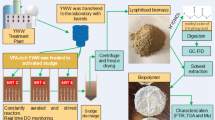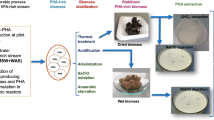Abstract
In this study, activated sludge bacteria from a conventional wastewater treatment process were induced to accumulate polyhydroxyalkanoates (PHAs) under different carbon-nitrogen (C:N) ratios. As the C:N ratio increased from 20 to 140, specific polymer yield increased to a maximum of 0.38 g of polymer/g of dry cell mass while specific growth yield decreased. The highest overall polymer production yield of 0.11 g of polymer/g of carbonaceous substrate consumed was achieved using a C:N ratio of 100. Moreover, the composition of polymer accumulated was dependent on the valeric acid content in the feed. Copolymer poly (3-hydroxybutyrate-co-3-hydroxyvalerate) [P(3HB-co-3HV)] was produced in the presence of valeric acid. The 3-hydroxyvalerate (3HV) mole fraction in the copolymer was linearly related tovaleric content in the feed, which reached a maximum of 54% when valeric acid was used as sole carbon source. When the 3HV U in the polymer increased from 0–54 mol%, the melting temperature decreased from 178° to 99°C. Thus, the composition, and hence the mechanical properties, of the copolymer produced from activated sludge can be controlled by adjusting the mole fraction of valeric acid in the feed medium.
Similar content being viewed by others

References
Chua, H., Yu, P. H. F., Xing, S., and Ho, L. Y. (1995), J. Plast. Technol. 18, 132–148.
Hong Kong Government Industry Department (1991), in Techno-Economic and Market Research Study of Hong Kong Plastic Industry, vol. 1, 1990–1991, Hong Kong Government Press.
Chang, H. N. (1994), in Better Living Through Innovative Biochemical Engineering, Teo, W. K., ed., Singapore University Press, National University of Singapore, Singapore, pp. 24–30.
Chua, H., Yu, P. H. F., Xing, S., and Ho, L. Y. (1995), Potential of Biodegradable Plastics as Environmentally-Friendly Substitutes for Conventional Plastics in Hong Kong. Presented in 17th Symposium on Biotechnology for Fuelsand Chemicals, May 1995, CO.
Sang Yup Lee (1996), Biotechnol. Bioeng. 49, 1–14.
Suzuki, T., Yamane, T., and Shimizu, S. (1986), Appl. Microbiol. Biotechnol. 24, 370–374.
Maness, P.-C. and Weaver, P. F. (1994), Appl. Biochem. Biotech. 45/46, 395–407.
Page, W. J. (1989), Appl. Microbiol. Biotechnol. 31, 329–333.
Page, W. J. (1992), FEMS Microbiol. Rev. 103, 149–158.
Page, W. J. and Knosp, O. (1989), Appl. Environ. Microbiol. 55, 1334–1339.
Chua, H., Yu, P. H. F., and Ho, L. Y. (1997), Appl. Biochem. Biotechnol. 63, 627–635.
Chua, H., Yu, P. H. F., and Ho, L. Y. (1997), J. IES Chem. Eng. 37(2), 9–13.
Kim, G. J., Yun, K. Y., Bae, K. S., and Rhee, Y. H. (1992), Biotechnol. Lett. 14, 27–32.
American Public Health Association (1995), Standard Methods for the Examination of Water and Wastewater, 19th ed., Washington, DC.
Lowell, L. W. and Edwin, N. D. (1972), Env. Sci. Technol. 6(2), 161–164.
Ho, L. Y. (1997), Synthesis of Environmentally Friendly Materials, Master Thesis, The Hong Kong Polytechnic University, Hung Hom, Kowloon, Hong Kong, China.
Doi, Y., Segawa, A., and Kunioka, M. (1990), Intl. J. Biol. Macronol. 12, 106–111.
Bluhm, T. and Marchessualt, R. H. (1988), Can. Chem. News. 40, 25–26.
Ishihara, Y., Shimizu, H., and Shioya, S. (1996), J. Ferment. Bioeng. 81, 422–428.
Yamane, T. (1993), Biotechnol. Bioeng. 41, 165–170.
Dave, H., Ramakrishna, C., and Desai, J. D. (1996), Indian J. Exp. Biol. 34, 216–219.
Author information
Authors and Affiliations
Rights and permissions
About this article
Cite this article
Chua, H., Yu, P.H.F. & Ma, C.K. Accumulation of biopolymers in activated sludge biomass. Appl Biochem Biotechnol 78, 389–399 (1999). https://doi.org/10.1385/ABAB:78:1-3:389
Issue Date:
DOI: https://doi.org/10.1385/ABAB:78:1-3:389



